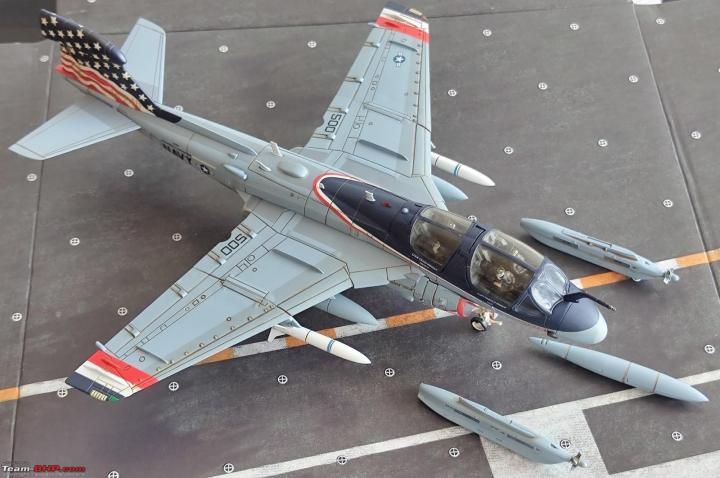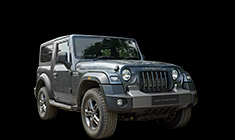News
Scale models of four fighter aircraft with great attention to detail
Prowlers flew with Navy and Marine squadrons from 1970 to 2019, also protecting US and allied warplanes from enemy attack.
BHPian skanchan95 recently shared this with other enthusiasts.
1:72 Northrop Grumman EA-6B Prowler Bu No. 163046/AG500, VAQ-140 "Patriots" United States Navy, USS Dwight D. Eisenhower CVN-69, Operation Enduring Freedom, 2006 (JC Wings)
Developed from the EA-6A Electronic Intruder and operated by the US Navy & US Marine Corps, the EA-6B Prowler was a carrier-based electronic warfare aircraft that was first flown on May 25th, 1968. The Prowler was a key element of any US Navy or US Marine Corps strike force that disrupted and jammed enemy radio and radar signals, and provided protection for attacking aircraft as they carried out their mission. The Prowler could also be armed with AGM-88 anti-radiation missiles that were designed to home-in on enemy radar installations and neutralize surface-to-air missile threats. After a long history with the EA-6B, the US Navy began transitioning to the Boeing E/A-18G Growler in 2009.
The Prowler was the first U.S. military aircraft specifically designed for tactical electronic warfare — jamming enemy radar and communications while escorting aircraft on strike and bombing missions. More than 30 antennae distributed around the airplane detected radio and radar signals, and it carried up to five underwing jamming transmitter pods.
Prowlers flew with Navy and Marine squadrons from 1970 to 2019, also protecting US and allied warplanes from enemy attack. When Congress lifted a ban in 1993 on women in combat aircraft, Prowlers were among the first with women pilots and crew. No Prowlers were lost in combat.
The EA-6B was also used extensively to jam or activate radio controlled improvised explosive devices (IEDs) in Iraq and Afghanistan, protecting the lives of soldiers on the ground.
The EA-6B was a further evolution of the twin-seat EA-6A Electronic Intruder (which more or less looked exactly like the twin-seat A-6 Intruder attack aircraft). The forward fuselage of the EA-6A was lengthened to create a rear area for a larger four-seat cockpit, and an antenna fairing was added to the tip of its vertical stabilizer. The AN/ALQ-99 Tactical Jammer System (TJS) was the core of the EA-6B.
The AN/ALQ-99's primary receiving antennas were housed in a fixed pod on top of the tailfin, like that on the EA-6A, with additional antennas on the side of the tailfin. It housed sensitive surveillance receivers, capable of detecting hostile radar emissions at long range. Emitter information was processed by the central mission computer. Detection, identification, direction-finding, and jammer-set-on-sequence could be performed automatically or by the crew. Other jammer gear was to be carried on the underwing pylons. The jamming transmitters and exciter equipment were housed in under-wing pods (removeable). HARM anti-radiation missiles were also carried depending on mission requirements.
There were four crew on the EA-6B - a pilot and three ECMOs(Electronic Counter Measures Officer), sitting in a 2x2 arrangement on Martin-Baker Mark 7 ejection seats, with the front-seat ECMO doubling as a navigator. There were separate back-hinged clamshell canopies for each of the two rows of seats. The canopies were coated with a thin gold film to protect the crew from the powerful emissions produced by the aircraft's jammer systems.The pilot sat on the front port side with an ECMO/Navigator on his right. The other two ECMOs sat in the rear cockpit side by side. The ECMO in the right front seat was responsible for navigation, communications, and defensive electronic countermeasures. The underwing ALQ-99 jammer pods were operated by the two ECMOs in the aft cockpit.
The additional weight of the fuselage extension and additional equipment led to reinforced wings and landing gear on the EA-6B. The internal fuel capacity was also increased. An AN/APQ-129 radar was fitted in the nose to help support attacks with Shrikes ARMs or other munitions, with an AN/APN-153 Doppler navigation radar fitted as well, along with an AN/ALQ-100 defensive jammer system.
Three A-6As were modified as initial prototypes of the EA-6B, with the first flying in its new form on 25 May 1968. The first production EA-6B performed its first flight in November 1970, with service deliveries beginning the next year, 1971. Initial production machines had J52-P-8A engines, with later production featuring uprated Pratt & Whitney J52-P-408 engines providing 49.8 kN (5,080 kgp / 11,200 lbf) thrust each, and most early machines retrofitted with these engines.
The EA-6Bs were regarded as sufficiently different from other Intruder variants to be given a new name: "Prowler". They were available for combat operations over Southeast Asia in the very last months of the US involvement in the Vietnam War, suffering no losses. 170 new-build Prowlers were manufactured up to the end of production in 1991.
The Prowler was replaced in US Navy service by an ECM derivative of the Boeing F/A-18E/F Super Hornet - the "EA-18G Growler". The last service flight of a US Navy Prowler was on 27 June 2015. US Marine Corps continued to operate the Prowler till 2019.
US Marine Corps Prowlers were in action in 2018, flying missions out of Qatar to jam communications of Islamist insurgents in Syria -- but that was the end of it, the Prowler being retired by the US Marine Corps in 2019. The Marines did not replace their Prowlers with Growlers, instead, they were thinking of replacing it with a vertical take-off drone that could operate off assault ships, to conduct electronic warfare, early warning, surveillance, and communications relay missions. They also would like the drone to carry light guided weapons to deal with "time-critical targets" -- that is, that have to be engaged when spotted, or they'll get away -- and possibly a light cargo load as a secondary mission.
VAQ-140 "Patriots"

With a squadron radio callsign of "Talon" and known as America's squadron, Electromagnetic Attack Squadron ONE FOUR ZERO (VAQ-140) "Patriots" was established on October 1, 1985 on the EA-6B Prowler, and was immediately tasked with the evaluation and testing of the AGM-88 High-speed Anti-Radiation Missile (HARM) on their Prowlers. It became the first Prowler squadron to operationally deploy with HARMs aboard USS John F. Kennedy in August 1986. The squadron was deployed aboard USS Dwight D. Eisenhower for the beginning of Operation Desert Shield in September 1991.
In 1999, in support of Operation Allied Force(NATO bombing of Yugoslavia), they assumed Command of Electronic Attack Wing Aviano, which consisted of 100 Aircrew and 300 Support Personnel. While flying over 740 combat missions and 3300 flight hours, 117 AGM-88 HARMs were fired against the enemy, earning the Patriots a Navy Unit Commendation Medal.
The squadron returned to the Persian Gulf aboard the Eisenhower for Operation Southern Watch in 2006. On October 3, the Patriots and its EA-6Bs made its first of five deployments onboard the USS Dwight D. Eisenhower in support of Operation Enduring Freedom. On June 20, 2012 the "Patriots" began their last deployment on the USS DDE with the EA-6B. VAQ-140 returned home to NAS Whidbey Island and began the process of retiring the Prowler for the new EA-18G Growler.The squadron completed transition to the EA-18G Growler in July 2014.
General characteristics
- Crew: 4 (one pilot, three electronic countermeasures officers)
- Length: 59 ft 10 in (18.24 m)
- Wingspan: 53 ft (16 m)
- Height: 16 ft 8 in (5.08 m)
- Wing area: 528.9 sq ft (49.14 m2)
- Empty weight: 31,160 lb (14,134 kg)
- Max takeoff weight: 61,500 lb (27,896 kg)
- Powerplant: 2 × Pratt & Whitney J52-P-408A turbojet engines, 10,400 lbf (46 kN) thrust each
Performance
- Maximum speed: 566 kn (651 mph, 1,048 km/h)
- Cruise speed: 418 kn (481 mph, 774 km/h)
- Range: 2,022 nmi (2,327 mi, 3,745 km) (tanks kept)
- 2,400 mi (2,100 nmi; 3,900 km) (tanks dropped)
- Service ceiling: 37,600 ft (11,500 m)
- Rate of climb: 12,900 ft/min (66 m/s)
- Wing loading: 116 lb/sq ft (570 kg/m2)
- Thrust/weight: 0.34
Armament
- Hardpoints: 5 total: 1× centerline/under-fuselage plus 4× under-wing pylon stations with a capacity of 18,000 pounds (8,200 kg), with provisions to carry combinations of:
- Missiles: Up to 4× AGM-88 HARM Anti-radiation missiles (typically 2x carried)
Other:
- Up to 5× 300 US gallons (1,100 L) external drop tanks
- Up to 5× AN/ALQ-99 Tactical Jamming System (TJS) external pods
- AN/ALE-43(V)1&4 Bulk Chaff Dispensing System pod
- AN/AAQ-28(V) Litening targeting pod (USMC only)
Avionics:
- AN/ALQ-218 Tactical Jamming System Receiver
- AN/USQ-113 Communications Jamming System

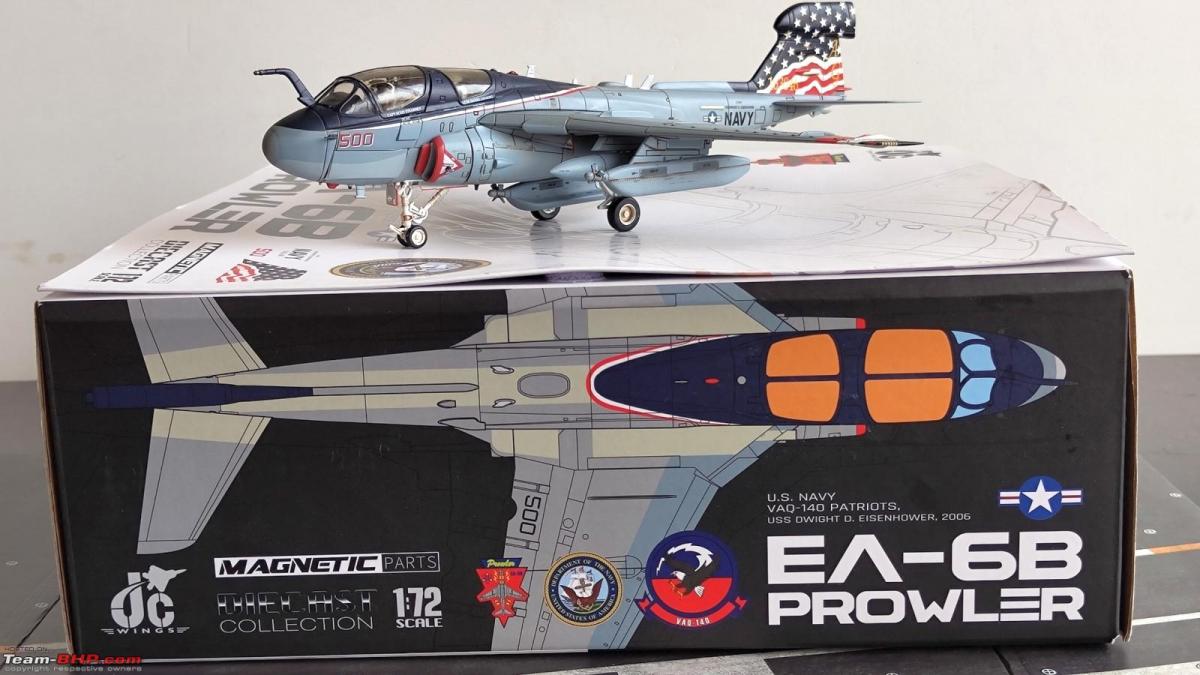


No. 198 of 600 models manufactured
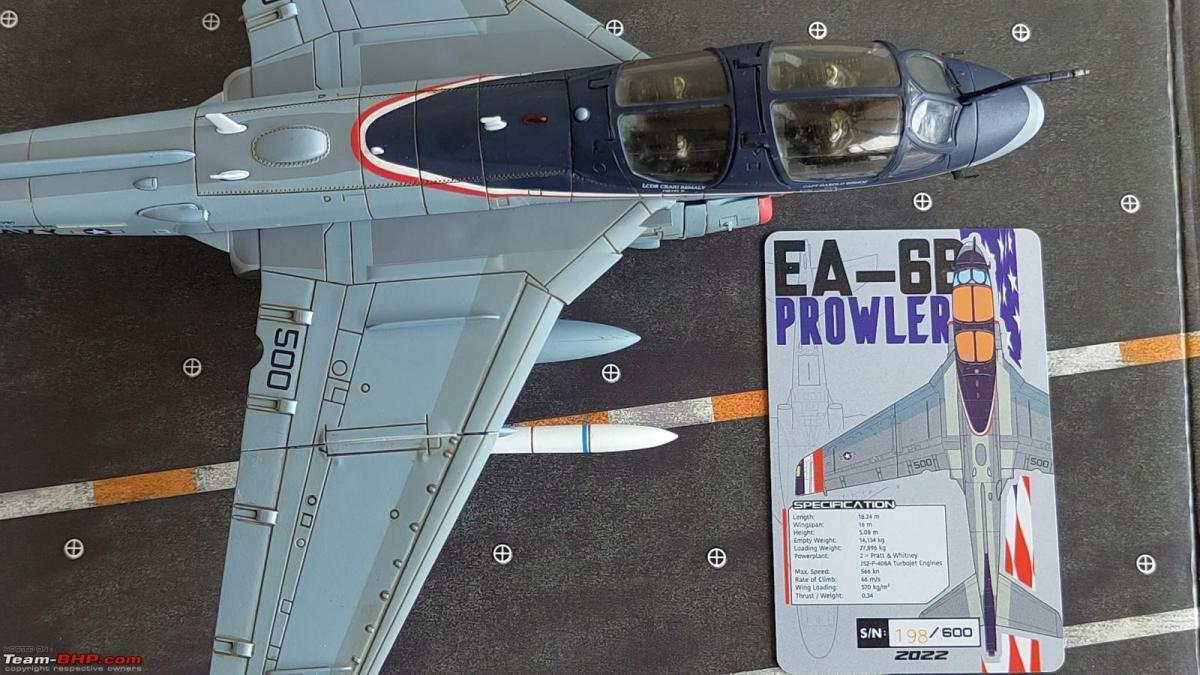

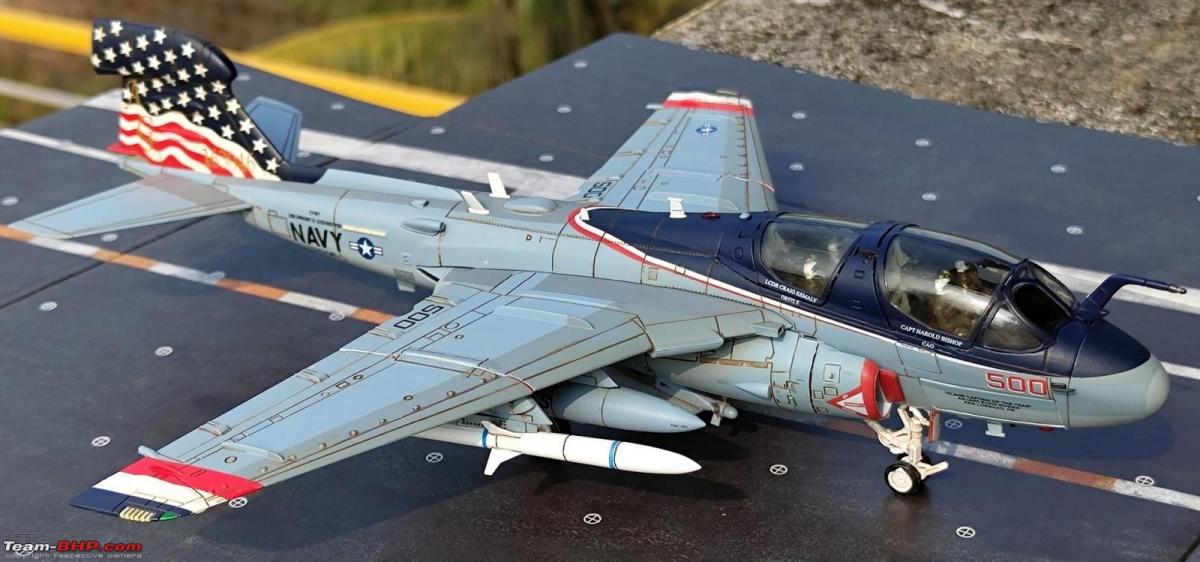



The attachment options

The AN/ALQ-99 Jammer pod with a RAT(Ram Air Turbine)






Cockpit details
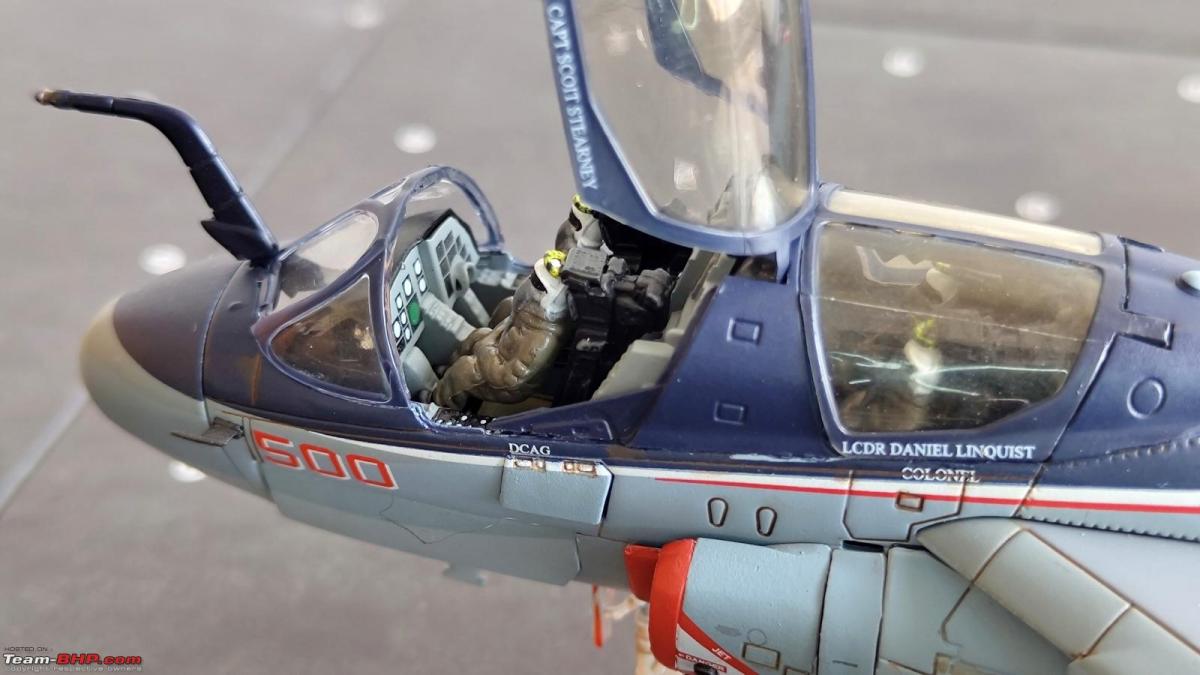



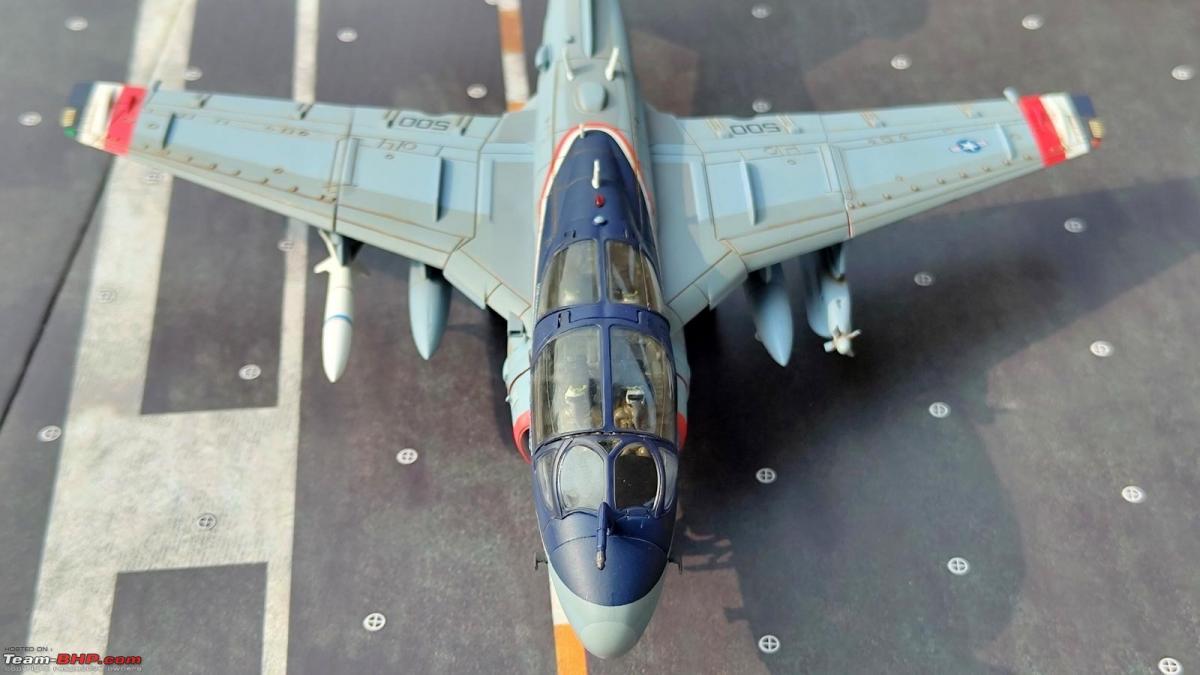
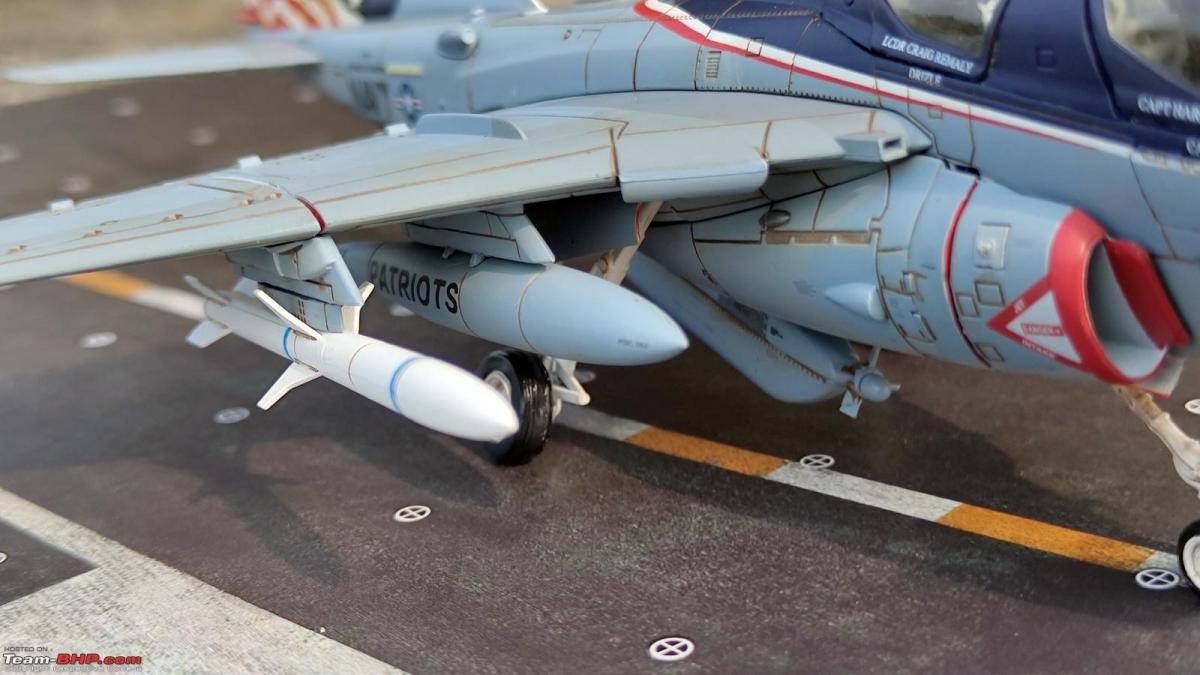
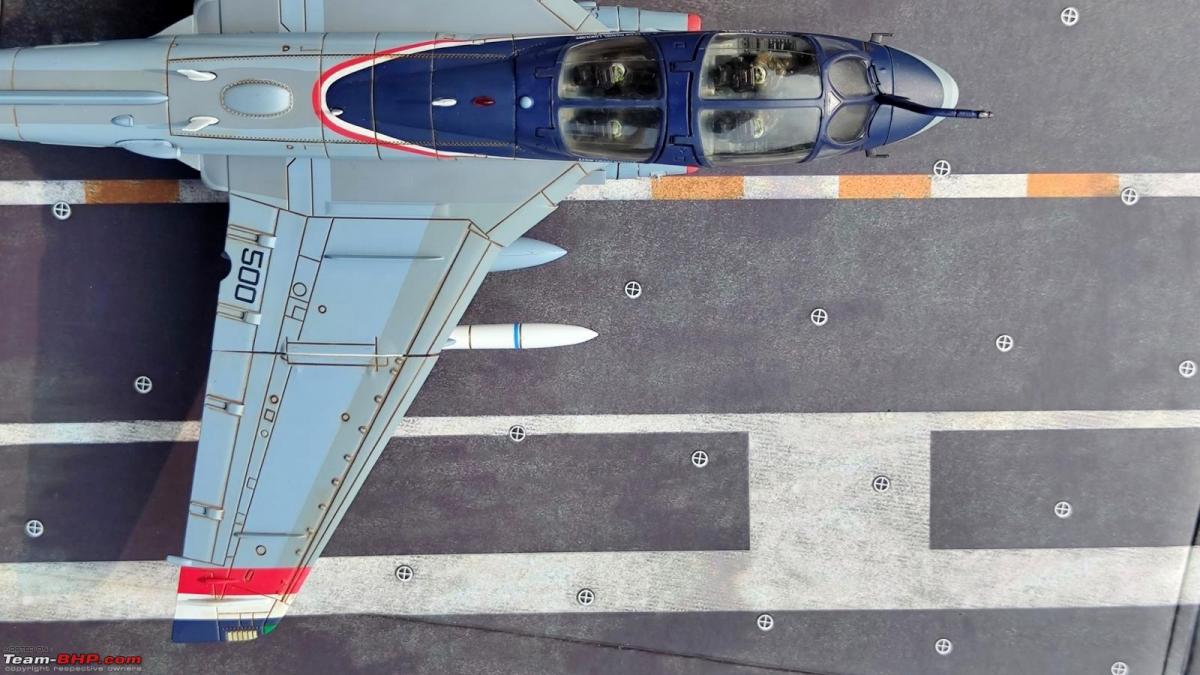


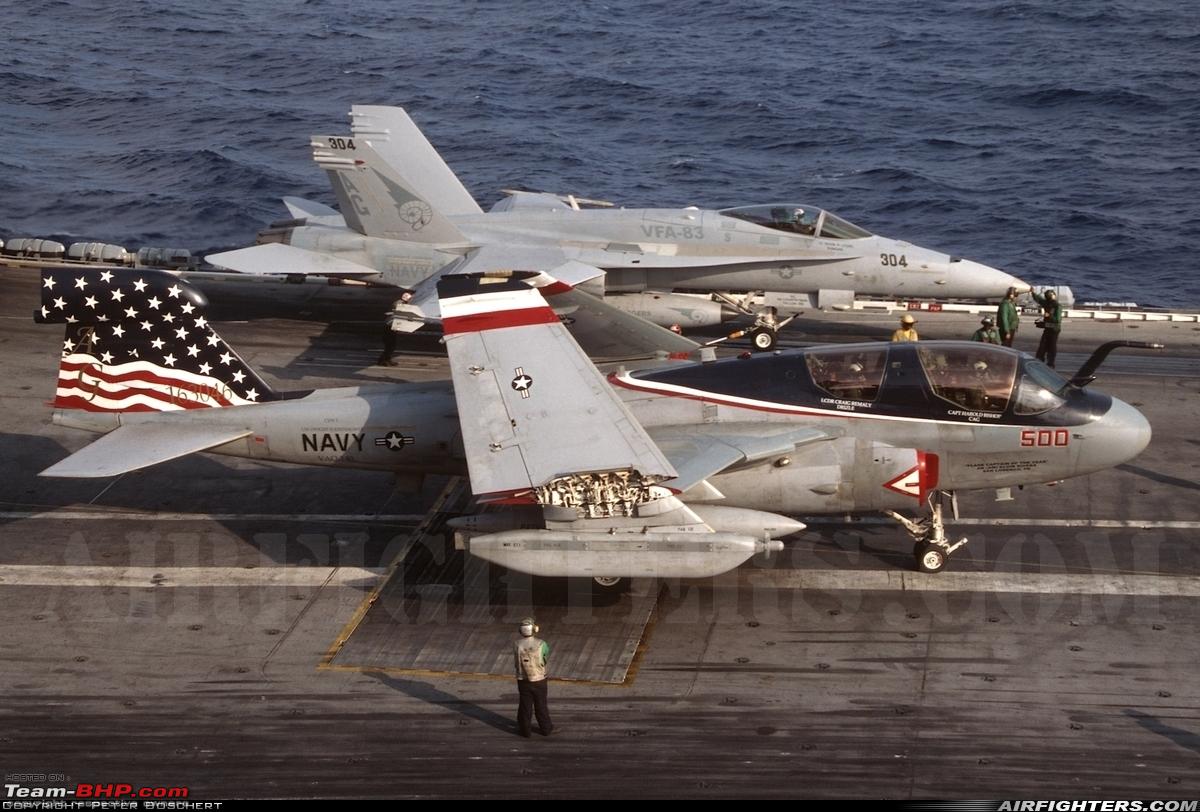
Continue reading about skanchan95's scale models for BHPian comments, insights and more information.



